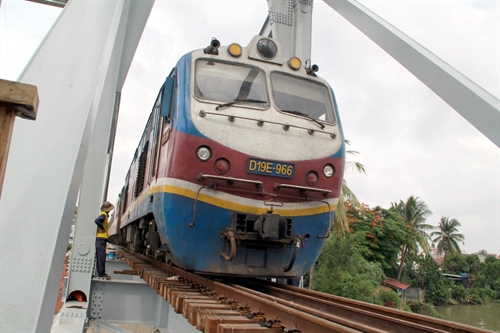 Society
Society

The new Ghềnh Bridge spanning Đồng Nai River in the southern province of Đồng Nai opened to traffic on Saturday, more than three months after the collapse of the old bridge.
 |
| The first North-South train runs through Ghềnh river on Saturday morning. The new bridge opened to traffic on Saturday, more than three months after the collapse of the old bridge. VNA/VNS Photo |
ĐỒNG NAI – The new Ghềnh Bridge spanning Đồng Nai River in the southern province of Đồng Nai opened to traffic on Saturday, more than three months after the collapse of the old bridge.
Construction of the new bridge began on April 1 at an estimated cost of US$13 million. The new bridge is two metres higher than the old one, thus it can allow ships with bigger deadweights to pass through.
Before its operation, the Ghềnh Bridge was tested to make sure that it meets required technical standards. Đới Sỹ Hưng, Vice Director of the Việt Nam Railways Corporation, said remaining parts of the project will be completed by the end of the month.
The bridge’s pillar was destroyed by a towboat causing many people to fall into the river.
A towboat which was towing a barge with a plate number of SG 5984 and carrying about 600 tonnes of sand from Long An to Đồng Nai crashed into a bridge pillar on the morning of March 20, causing people to fall into the river. Two spans of the bridge collapsed after the crash.
As the bridge is on the North-South railway route, railway services have been stopped. Trains on the route now have to stop at the province’s Biên Hòa Station.
The towboat’s owner Phan Thế Thượng from Sóc Trăng Province reportedly let two unlicensed persons control the towboat, which violates the law, while the towboat was also out of date. The two men at the wheel of the towboat at the time of the accident, Trần Văn Giang, age 36, residing in Bạc Liêu Province and Nguyễn Văn Lẹ, age 28 from Sóc Trăng Province, fled immediately and were seized by the provincial police on March 21.
Thượng and Giang were then prosecuted for violating regulations on waterways traffic. Lẹ was free of charge as he was just in a supporting role and was not culpable for the accident.
The Ghềnh Bridge was built by the French in the 1900s during the colonial period and has been used for both railway and land transportation. - VNS




